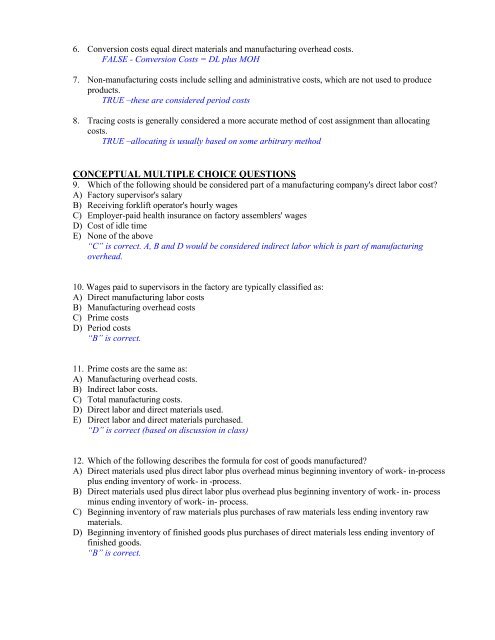(WIP) ACC 350 Exam 1 Study Material
Work in Process
Work in Process
You also want an ePaper? Increase the reach of your titles
YUMPU automatically turns print PDFs into web optimized ePapers that Google loves.
12.7-4 gas<br />
6. Conversion costs equal direct materials and manufacturing overhead costs.<br />
FALSE - Conversion Costs = DL plus MOH<br />
7. Non-manufacturing costs include selling and administrative costs, which are not used to produce<br />
products.<br />
TRUE –these are considered period costs<br />
8. Tracing costs is generally considered a more accurate method of cost assignment than allocating<br />
costs.<br />
TRUE –allocating is usually based on some arbitrary method<br />
CONCEPTUAL MULTIPLE CHOICE QUESTIONS<br />
9. Which of the following should be considered part of a manufacturing company's direct labor cost?<br />
A) Factory supervisor's salary<br />
B) Receiving forklift operator's hourly wages<br />
C) Employer-paid health insurance on factory assemblers' wages<br />
D) Cost of idle time<br />
E) None of the above<br />
“C” is correct. A, B and D would be considered indirect labor which is part of manufacturing<br />
overhead.<br />
10. Wages paid to supervisors in the factory are typically classified as:<br />
A) Direct manufacturing labor costs<br />
B) Manufacturing overhead costs<br />
C) Prime costs<br />
D) Period costs<br />
“B” is correct.<br />
11. Prime costs are the same as:<br />
A) Manufacturing overhead costs.<br />
B) Indirect labor costs.<br />
C) Total manufacturing costs.<br />
D) Direct labor and direct materials used.<br />
E) Direct labor and direct materials purchased.<br />
“D” is correct (based on discussion in class)<br />
12. Which of the following describes the formula for cost of goods manufactured?<br />
A) Direct materials used plus direct labor plus overhead minus beginning inventory of work- in-process<br />
plus ending inventory of work- in -process.<br />
B) Direct materials used plus direct labor plus overhead plus beginning inventory of work- in- process<br />
minus ending inventory of work- in- process.<br />
C) Beginning inventory of raw materials plus purchases of raw materials less ending inventory raw<br />
materials.<br />
D) Beginning inventory of finished goods plus purchases of direct materials less ending inventory of<br />
finished goods.<br />
“B” is correct.


